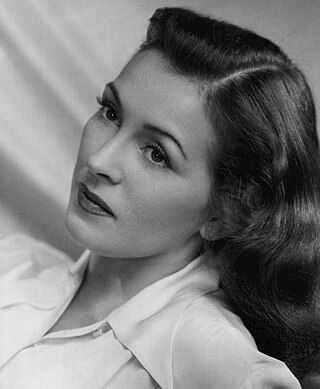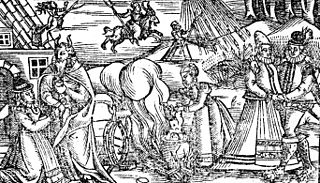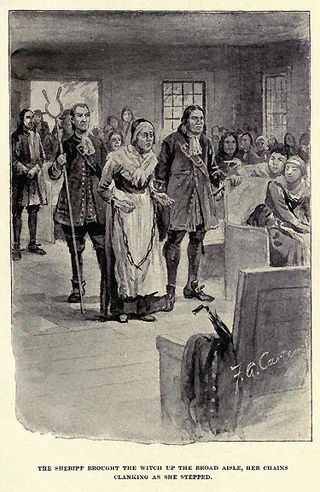
Witchcraft is the use of alleged supernatural powers of magic. A witch is a practitioner of witchcraft. Traditionally, "witchcraft" means the use of magic or supernatural powers to inflict harm or misfortune on others, and this remains the most common and widespread meaning. According to Encyclopedia Britannica, "Witchcraft thus defined exists more in the imagination", but it "has constituted for many cultures a viable explanation of evil in the world". The belief in witchcraft has been found throughout history in a great number of societies worldwide. Most of these societies have used protective magic or counter-magic against witchcraft, and have shunned, banished, imprisoned, physically punished or killed alleged witches. Anthropologists use the term "witchcraft" for similar beliefs about harmful occult practices in different cultures, and these societies often use the term when speaking in English.
Aradia is one of the principal figures in the American folklorist Charles Godfrey Leland's 1899 work Aradia, or the Gospel of the Witches, which he believed to be a genuine religious text used by a group of pagan witches in Tuscany, a claim that has subsequently been disputed by other folklorists and historians. In Leland's Gospel, Aradia is portrayed as a messiah who was sent to Earth in order to teach the oppressed peasants how to perform witchcraft to use against the Roman Catholic Church and the upper classes.

Nancy Kelly was an American actress in film, theater, and television. A child actress and model, she was a repertory cast member of CBS Radio's The March of Time, and appeared in several films in the late 1920s. She became a leading lady upon returning to the screen in the late 1930s, while still in her teens, and made two dozen movies between 1938 and 1946, including portraying Tyrone Power's love interest in the classic Jesse James (1939), which also featured Henry Fonda, and playing opposite Spencer Tracy in Stanley and Livingstone, later that same year. After turning to the stage in the late 1940s, she had her greatest success in a character role, the distraught mother in The Bad Seed, receiving a Tony Award for Best Actress in a Play for the 1955 stage production and an Academy Award nomination as Best Actress for the 1956 film adaptation, her last film role. Kelly then worked regularly in television until 1963, then took over the role of Martha in the original Broadway production of Who's Afraid of Virginia Woolf? for several months. She returned to television for a handful of appearances in the mid-1970s.

Isobel Gowdie was a Scottish woman who confessed to witchcraft at Auldearn near Nairn during 1662. Scant information is available about her age or life and, although she was probably executed in line with the usual practice, it is uncertain whether this was the case or if she was allowed to return to the obscurity of her former life as a cottar’s wife. Her detailed testimony, apparently achieved without the use of violent torture, provides one of the most comprehensive insights into European witchcraft folklore at the end of the era of witch-hunts.

In European folklore of the medieval and early modern periods, familiars were believed to be supernatural entities, interdimensional beings, or spiritual guardians that would protect or assist witches and cunning folk in their practice of magic, divination, and spiritual insight. According to records of the time, those alleging to have had contact with familiar spirits reported that they could manifest as numerous forms, usually as an animal, but sometimes as a human or humanoid figure, and were described as "clearly defined, three-dimensional... forms, vivid with colour and animated with movement and sound", as opposed to descriptions of ghosts with their "smoky, undefined form[s]".

Tituba was an enslaved Native American woman who was one of the first to be accused of witchcraft during the Salem witch trials of 1692–1693.

Scooby-Doo! and the Witch's Ghost is a 1999 American direct-to-video animated supernatural horror comedy film, and the second of the direct-to-video films based upon Scooby-Doo Saturday morning cartoons. It was produced by Hanna-Barbera Cartoons and Warner Bros. Animation. The film was released on VHS on October 5, 1999, then on DVD on March 6, 2001.
Mary Ann Warren was an accuser and later confessed witch during the 1692 Salem witch trials. She was a servant for John and Elizabeth Proctor. Renouncing her claims after threats of beating from her master, she was later accused and arrested for allegedly practicing witchcraft herself, after which she again became afflicted and accused others of witchcraft. Her life after the trials is unknown.

The Bideford witch trial resulted in hangings for witchcraft in England. Temperance Lloyd, Mary Trembles and Susannah Edwards from the town of Bideford in Devon were tried in 1682 at the Exeter Assizes at Rougemont Castle. Much of the evidence against them was hearsay, although there was a confession by Lloyd, which she did not fully recant even with her execution imminent. These women have been labelled as the last witches to be hanged in England, but there are subsequent cases which are not as well documented.

Rebecca Nurse was a woman who was accused of witchcraft and executed by hanging in New England during the Salem Witch Trials of 1692. She was fully exonerated fewer than twenty years later.
The history of Wicca documents the rise of the Neopagan religion of Wicca and related witchcraft-based Neopagan religions. Wicca originated in the early 20th century, when it developed amongst secretive covens in England who were basing their religious beliefs and practices upon what they read of the historical witch-cult in the works of such writers as Margaret Murray. It was subsequently founded in the 1950s by Gardner, who claimed to have been initiated into the Craft – as Wicca is often known – by the New Forest coven in 1939. Gardner's form of Wicca, the Gardnerian tradition, was spread by both him and his followers like the High Priestesses Doreen Valiente, Patricia Crowther and Eleanor Bone into other parts of the British Isles, and also into other, predominantly English-speaking, countries across the world. In the 1960s, new figures arose in Britain who popularized their own forms of the religion, including Robert Cochrane, Sybil Leek and Alex Sanders, and organizations began to be formed to propagate it, such as the Witchcraft Research Association. It was during this decade that the faith was transported to the United States, where it was further adapted into new traditions such as Feri, 1734 and Dianic Wicca in the ensuing decades, and where organizations such as the Covenant of the Goddess were formed.

The Basque witch trials of the seventeenth century represent the last attempt at rooting out supposed witchcraft from Navarre by the Spanish Inquisition, after a series of episodes erupted during the sixteenth century following the end of military operations in the conquest of Iberian Navarre, until 1524.

The Good Witch is a television film that aired on the Hallmark Channel on January 19, 2008. It stars Catherine Bell as Cassandra "Cassie" Nightingale and Chris Potter as chief of police Jake Russell. The film has spawned a franchise of six followup television films and the television series Good Witch.
Ursula Kemp or Ursley Kempe alias Grey was an English cunning woman and midwife who in 1582 was tried for witchcraft and hanged. Kemp was accused of using familiars to kill and bring sickness to her neighbour.
In the historical folklore of Sicily, Doñas de fuera were supernatural female beings comparable to the fairies of English folklore. In the 16th to mid-17th centuries, the doñas de fuera also played a role in the witch trials in Sicily.

The trials of the Pendle witches in 1612 are among the most famous witch trials in English history, and some of the best recorded of the 17th century. The twelve accused lived in the area surrounding Pendle Hill in Lancashire, and were charged with the murders of ten people by the use of witchcraft. All but two were tried at Lancaster Assizes on 18–19 August 1612, along with the Samlesbury witches and others, in a series of trials that have become known as the Lancashire witch trials. One was tried at York Assizes on 27 July 1612, and another died in prison. Of the eleven who went to trial – nine women and two men – ten were found guilty and executed by hanging; one was found not guilty.
The St Osyth Witches were 14 women who were tried for witchcraft in Essex in 1582. A village near Brightlingsea in Essex, St Osyth was home to 14 women who were put on trial for witchcraft, some of whom were duly convicted according to law.

Death at Love House is a 1976 American made-for-television horror film directed by E.W. Swackhamer and starring Robert Wagner, Kate Jackson, Sylvia Sidney and Marianna Hill. The film aired on the ABC network on September 3, 1976.

Margaret Aitken, known as the Great Witch of Balwearie, was an important figure in the great Scottish witchcraft panic of 1597 as her actions effectively led to an end of that series of witch trials. After being accused of witchcraft Aitken confessed but then identified hundreds of women as other witches to save her own life. She was exposed as a fraud a few months later and was burnt at the stake.

Lilias Adie was a Scottish woman who lived in the coastal village of Torryburn, Fife, Scotland. She was accused of practising witchcraft and fornicating with the devil but died in prison before sentence could be passed. Her intertidal grave is the only known one in Scotland of an accused witch – most were burned.














